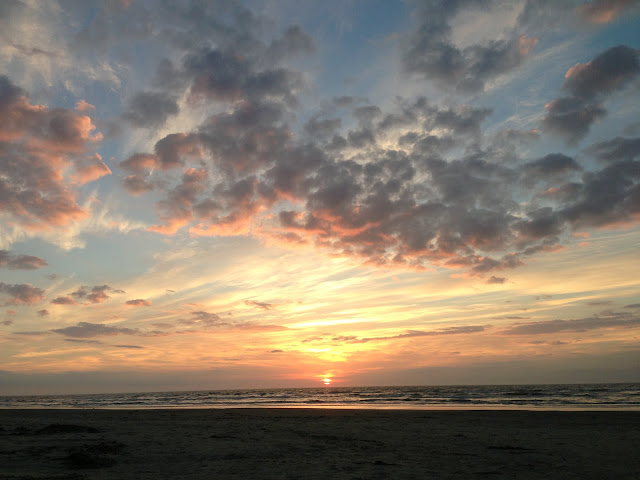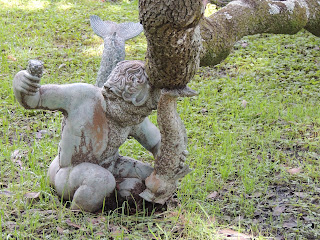January 18: The area around Vicksburg and Natchez is home to many former and current cotton plantations. We drove by a few fields that had not been picked, but most of the fields were in their winter dormancy.

Given the choice of many historic homes to visit in this area, we read about a number of them and chose to visit Frogmore Plantation, which is of both historic and current interest; it is also across the Mississippi from Natchez, located near Vidalia, LA.
Frogmore (the family name of the original owners), is unique in that it is still a very large active cotton farm (now called Frogmore Farm), but also because the owners have a very strong interest in preserving and sharing the history of this region and specifically Frogmore Plantation. To that end, they have worked hard to both salvage existing buildings on the original site and to locate, purchase and move other structures from the appropriate time period (pre-Civil War) to the site to recreate the appearance of the original plantation outbuildings. At Frogmore, the plantation house itself is not available to tour - the owners still live in that home - but the reconstructed slave quarters, commissary, and old cotton gin and cotton storage buildings are available to visit.

When we called to inquire about tour times, we discovered that the facility was closed for the winter and available for tours only by special advance arrangement. Hearing that we were traveling through the area from Michigan and not likely to return in the spring, they arranged for a guide to meet us at the plantation for a private tour. That's Southern hospitality at it's best!
 |
| This one's for you Mick and Katie Kish! |
We met our guide for an interesting, albeit soggy tour of the quarters and explanation of the workings of the old gin, followed by a film showing the modern gin. It was a beautiful, blue-sky day, following almost two weeks of non-stop rain, so the ground literally squished beneath our feet, but the guide took us around the buildings, sharing information about the lives of the slaves, overseers, and subsequent sharecroppers who inhabited these buildings, and to the edge of field where cotton had been allowed to remain standing so visitors can get an up-close and personal experience with a cotton field and pick some cotton if desired. The tour guide emphasized the necessity and value of the slave labor for maintaining an active and thriving cotton plantation in the years leading to the Civil War, when the entire process of cotton production was manually extremely labor intensive, and then compared it to the present day mechanized approach to the growing cotton.

Having seen similar buildings in other tours of historic places, the old beds, ragged quilts, open-fire cooking was not new to us, although always interesting to see and compare to our modern conveniences. We were, however, surprised to learn that the term 'cotton gin' is short for 'cotton engine' (did a teacher somewhere in our youth point that out to us?) and also somewhat surprised to learn of the wide variety of products made from cotton plants in addition to the cloth that we typically envision when hearing the term 'cotton'. The plants actually produce two different crops: fiber, and seed. Only 5% of the seed from any harvest is returned to the field as seed for new plants; the remainder is all sold to the
cottonseed processing industry, which in turn provides raw materials to food, pharmaceutical, agricultural and cosmetics industries. Cotton fiber is still sold and moved in huge 600-800 lb. bales.
I'll leave you with a final fascinating factoid about the value of cotton seed: the current owners of Frogmore Farm, George and Lynnette Tanner, operate a gin that processes the cotton from 50 other farms for free; in exchange, they get to keep the seed, which they in turn sell. That seed is how they make a living, and through which they have become recognized as leaders in the cotton industry in the US.
 First, the seafood: amazingly fresh locally caught fish along with some frozen seafood from other areas, but since our travel focus has been on experiencing the LOCAL environment, food, music, and entertainment, we've purchased and feasted on local fish: redfish and red snapper. Coming from Michigan, where the fish we purchase "fresh" all has a rather "fishy" odor, walking into the harbor-side seafood shops here is a totally different experience - the fragrance is sweet, light, very pleasant.
First, the seafood: amazingly fresh locally caught fish along with some frozen seafood from other areas, but since our travel focus has been on experiencing the LOCAL environment, food, music, and entertainment, we've purchased and feasted on local fish: redfish and red snapper. Coming from Michigan, where the fish we purchase "fresh" all has a rather "fishy" odor, walking into the harbor-side seafood shops here is a totally different experience - the fragrance is sweet, light, very pleasant. In our favorite place, the display of
In our favorite place, the display of










































